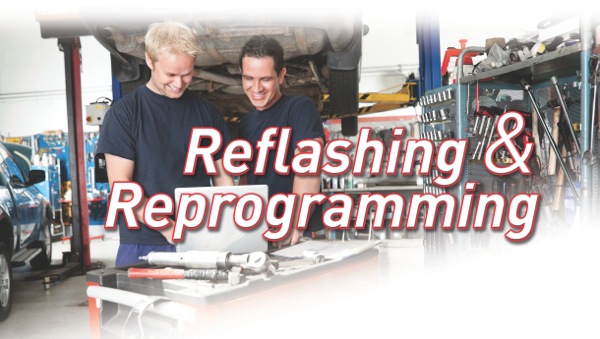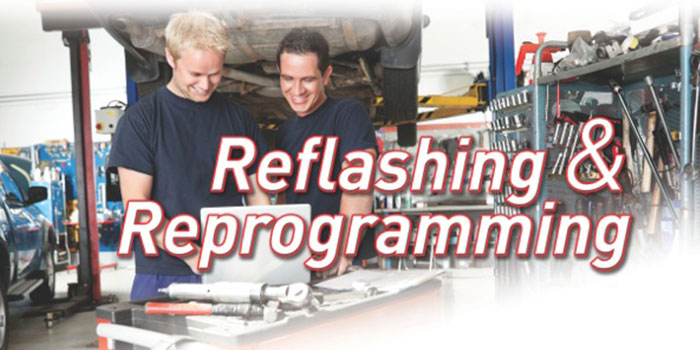
Developing the in-house capability for reflashing and reprogramming is critical for shop productivity and customer retention. Below are seven tools you need for reflashing as well as eight problems that can be resolved by reflashing.
7 Tools You Need To Reflash
1. Computer
Most OEMs require a Windows-based PC with specific hardware, operating system requirements and user settings. Most OEMs specify Vista and Windows 7. Some systems specify that the system be 32- or 64-bit versions of Windows. Make sure to read all of the OEMs’ recommendations for the largest volume of vehicles you plan to reflash. The computer should only be used for reflashing and navigating OEM websites.
2. Internet Connection
You must have a stable Internet connection to reflash modules. You can’t download a vehicle reflash file at home and install it when you get to the shop. The PC must remain connected to the Internet during the entire procedure or the module could be damaged. If your Wi-Fi is unstable, use a LAN/ethernet connection.
3. J2534 Pass-Thru Programmer
A J2534 pass-thru programmer is a box and/or cable able to connect the PC to the vehicle and communicate with the correct pins on the OBD II connection. It is an interface that acts as a gateway that translates the messages back and forth between the PC and controller into a protocol that is understood by the vehicle.
Most reflashing methods require the use of the four pins in the DLC that are open to the manufacturer.
4. Voltage Supply
Some reflash sessions can last more than 45 minutes. If the battery voltage drops below a set voltage, the reflashing process will stop and possibly damage the module. Voltages are changing and can vary from 12 to 14 volts. Check the OEM’s website for information.
Note: An old battery charger should not be used. There are battery chargers/power supplies made specifically for reflashing that can deliver the correct voltage and amps during the procedure.
5. Advanced Scan Tool
Your scan tool should be the equivalent to the factory tool or better. It must be able to read Calibration Verification Numbers (CVN) and Mode $09 data. It should also be able to perform certain relearn and recalibration procedures.
6. Subscriptions
You will need to subscribe to the OEM’s service information website. Subscription fees vary by OEM and have several payment options. Make sure you write down the logins and passwords. Before you start reflashing, take time to register and navigate the OEMs’ websites. Bookmark important pages on the sites.
7. Time
You will not be able to perform flash reprogramming straight out of the box. It takes time to set up the computer and register at the OEM websites. On a slow day, take some time to experiment on shop vehicles. Nothing is worse than having to wait for a verification email from an OEM to start up a subscription. Learn before you burn.
8 Vehicle Problems Solved By Reflashing
1. Carbon Buildup on Direct Injection Engines: Reflash programming can help stop carbon buildup on some vehicles. New software can reduce carbon deposits by reducing the exposure of the valves to conditions that cause buildup by adjusting valve and spark timing. Don’t assume that you will find a TSB saying that a reflash of the ECM will correct a carbon buildup problem because most of the updates will be contained in normal housekeeping calibrations that may never say anything about a problem. Check the OEM’s website to see if the vehicle has the latest version of the software.
2. P0420 Converter Efficiency Codes: If a car with a converter efficiency code keeps coming back even after oxygen sensor and converter replacement, the long-term solution might be reflashing.
Most converters start out at about 99% efficiency when new and quickly taper off to about 95% efficiency after 4,000 miles or so of driving. As long as efficiency doesn’t drop off more than a few percentage points, the converter will do a good job of cleaning up the exhaust. But if efficiency drops much below 92%, it will usually turn on the MIL.
New programs can decrease the sensitivity drops in efficiency that may be caused by monitors that are too sensitive for the real world. Also, some reflash TSBs require the installation of an updated oxygen sensor that the new reflash software is calibrated for.
3. Oil Consumption: If you have a customer complaining that they are adding oil often, the solution may be to reflash the ECM and not rebuild the engine. Almost every vehicle with cylinder deactivation can benefit from a reflash update. Honda and GM have issued TSBs recommending reflash of the ECM to solve oil consumption problems on vehicles with cylinder deactivation. The new programming changes the valve timing so excessive vacuum is not created on the combustion stroke that can suck oil into the rings.
4. Brake Wear Problems: Have a vehicle that is wearing rear pads faster than the fronts? The solution could be reflashing the ABS module. Ford and Honda have solved brake wear issues by reflashing the ABS module and implementing new pad formulations.
Many OEMs use electronic brake force distribution (EBD) to dynamically change the brake bias using the ABS modulator. EBD eliminates the need for proportioning and combination valves. It can also change the bias as the drive slows down to prevent a nosedive. New software updates the behavior to maximize pad life.
5. Transmission Problems: Have a customer with transmission problems like slipping, shift flare or poor shift quality? The solution could be a reflash. With five-, six- and even nine-speed automatic transmissions, the shift behavior is regulated with more sensors and solenoids than ever before. Reflashing new calibrations for the transmission can solve shifting and even wear issues without having to rebuild the transmission.
Many OEMs are issuing new calibrations to account for wear to the bands and clutches that they did not see in their initial testing.
6. Battery Drains: If a vehicle has an intermittent battery drain that can’t be detected during normal diagnostics, look for a TSB that might include a reflash. With most modern vehicles, the vehicle doesn’t completely shut down when the key is removed from the ignition. Some modules will stay awake and even wake up while the car is sitting overnight. If a module or system doesn’t shut down or doesn’t receive the correct information from a sleeping module, it can stay awake and drain the battery. These problems can be extremely intermittent and frustrating to solve, but a check of the TSBs and latest calibration can save the shop and the customer time and money.
7. Component Replacement: If you’re installing a new module, you’ll have to flash it with the correct program to complete the repair. Some modules have switchable PROMs or come already programmed, but these are becoming the exception and not the norm.
8. ABS Problems: A common theme of some recent TSBs has been the performance of the ABS modulator. The majority of these TSBs are about the sensitivities of the system so the customer will not notice low-speed activation or a self-test when the vehicle reaches 5-10 mph.














